FIELD VETERINARY REPORT FOR SOUTHERN CONSERVATION AREA MOBILE VETERINARY UNIT FOR THE MONTH OF APRIL 2017 Reported by Ndambiri Ephantus Introduction For the better part of the month, the Southern Conservancy Area Mobile Veterinary Unit was on annual leave hence the lower number of cases recorded during the month
FIELD VETERINARY REPORT FOR SOUTHERN CONSERVATION AREA MOBILE VETERINARY UNIT FOR THE MONTH OF APRIL 2017
Reported by Ndambiri Ephantus
Introduction
For the better part of the month, the Southern Conservancy Area Mobile Veterinary Unit was on annual leave hence the lower number of cases recorded during the month.
The cases attended to include an elephant and zebra wound treatment, zebra postmortem and giraffe de-snaring
The following are veterinary activities attended to during the month;
CASE #1 TREATMENT OF ELEPHANT
Date: 2nd April 2017
Species: Elephant
Sex: Male
Age: Adult
Location: Dakota; Tsavo East National Park
History
This elephant was reported by the Kaluku Operations Center as being lame and in need of treatment. The Vet was picked by a DSWT Super Cub from Amboseli National Park Airstrip and flown to the Dakota airstrip where the Tsavo Trust ground team based at Dakota directed the vet to the elephants location.
Immobilization, examination and treatment
The candidate was darted using 15mgs Etorphine in a 1.5cc dart and took 21 minutes to go down on right lateral recumbence. It depicted a light level of anesthesia and thus an additional 2mgs Etorphine was injected through the ear vein. He was blindfolded using the left ear and the trunk was maintained patent using a piece of stick placed across the distal nares. Water was dowsed on the ears to help cool the animal through the treatment.
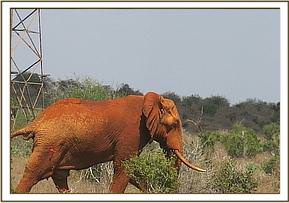

The team attempted to flip the elephant onto the left side using straps and a vehicle. Despite several attempts it was not possible hence examination and treatment had to be done on a partially obstructed wound. The dart was also not easy to recover since it had been obscured by the body. The wound was an open wound caused by a superficial spear or an arrow which didn’t penetrate the muscles underneath. The wound was approximately 15cm in diameter and was estimated to be over two weeks old.
The pus was removed from the wound using swabs. The wound was then cleaned with Hydrogen Peroxide and Iodine, followed by infiltration of two tubes of Cloxacillin antibiotic cream into the subcutaneous pus drained pocket. Topically the wound was covered with wetted green clay. Another little wound with creamy pus was discovered near the spine. This was also cleaned and covered with clay. Systemically, the elephant was covered with 6000mgs Amoxicillin intramuscularly and 30mgs Dexamethasone into ear vein.
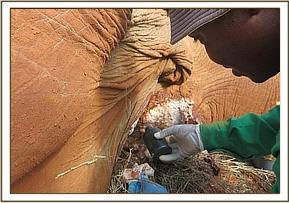

Reversal and Prognosis
Reversal of the anesthetic was achieved using 60mgs Naltrexone mixed with 12mgs Diprenorphine in one single syringe and administered into ear vein. It was up after three minutes and walked away slowly flapping its ears. The dart fell out as the elephant got to its feet and was recovered shortly after the animal strolled away.
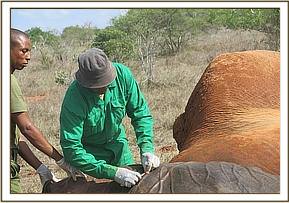
Prognosis is favourable.
CASE#2 TREATMENT OF ZEBRA
Date: 3rd April 2017
Species: Zebra
Sex: Female
Age: Adult
Location: Jakta, Amboseli National Park
History
This zebra was reported by the Amboseli Investigation Officer in-charge after he was informed by Big Life Foundation rangers. The zebra was said to have a whole spear lodged in its head. The vet was not able to attend on the same day because he was attending a treatment in Dakota. It was revisited the following day and was found in the same location in the company of others but always trailing behind or under the shade.
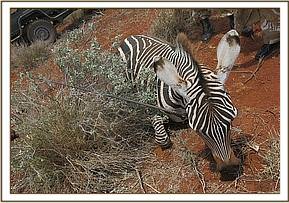

Immobilization, examination and treatment
The zebra was darted using 5mgs Etorphine and 60mgs Azaperone in a 1.5cc dart. It was approached slowly using a vehicle and darted in the left shoulder. It was completely on sternal recumbence in four minutes.
The spear hit the head from the right side caudal to right eye and penetrated through emerging at the left eye rostrally. Surprisingly the animal was spotted grazing, chewing and able to swallow but with a lot of caution. The resultant wound had begun to have foul smell indicating it was at least three days old. Both nostrils depicted reddish mucopurulent discharge. The spear had to be retrieved carefully so as not to cause any trauma. Pulling the spear out was the only option. Two men pulled the spear as two others held the head tightly. It was successfully retrieved.
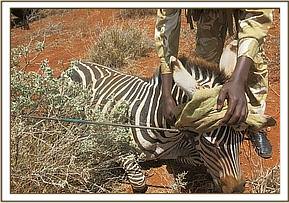

The resultant wound was cleaned with Hydrogen Peroxide and Iodine thoroughly from both sides. There was intercommunication and then three tube of Cloxacillin antibiotic cream were in filtrated into the cavity. Discharge could be seen through both nostrils. A heavy bleeder was experienced from the right entrance. It was first controlled by pressure using swabs but it continued to bleed. Eventually wet green clay was introduced into the cavity and the packing of the wound stopped any further bleeding. Topically the wounds were sprayed with Tetracycline wound spray.


Systemically the zebra was covered with 2000mgs Tetracycline intramuscularly, 20mgs Dexamethasone into the jugular vein and 8mgs Ivermectin under the neck muscles. The dart wound was infiltrated with a tube of Cloxacillin cream to counter abscess development
Reversal and Prognosis
It was revived from narcosis using 12mgs Diprenorphine into the jugular vein. It was up on all fours in three minutes and started walking after three minutes later.
Considering the unseen and undetermined injuries through the head and susceptibility of the species to tetanus it was granted guarded prognosis which will be revised after five days following the review of the case.


CASE#3 POSTMORTEM OF A ZEBRA
Date of death: Unknown
Date of Postmortem: 05/04/2017
Species: Zebra
Sex: Male
Age: Adult
Location: Isineti near Kimana Sanctuary
History
While on patrol along the Loitoktok - Emali road the Vet Unit spotted this dead carcass by the side of the tarmac road. We stopped by road side and embarked on observation.
General Observation
The zebra was lying on left lateral recumbence. The carcass was barely over 48 hours old. There was no discharge from the orifices and several cows were grazing within the locality. It was about ten meters from the edge of tarmac road. The carcass had good muscle cover.
Postmortem Findings
As the carcass was flipped over there was an open complete fracture on the left metacarpus proximally, there was also alopecic bruised areas on the brisket and on left scapular laterally. Its footprints were traced and it was possible that it was hit by a vehicle as it crossed the tarmac.

Conclusion
This animal died as a result of severe blunt injury to the left side caused by a speeding vehicle. The request to erect bumps and road signage to that effect was presented at nearby police station.
CASE #4 DESNARING OF GIRAFFE
Date: 6th April 2017
Species: Maasai Giraffe
Sex: Male
Age: Adult
Location: Chyulu National Park
History
It was reported by Big Life Foundation (BLF) operation center as having a tight neck snare. The vet responded immediately and was accompanied by a leading scout picked at BLF Head office. On the site we found area KWS officers together with BLF rangers who were keeping the candidate on sight.
Immobilization, examination and treatment
This giraffe was found alone walking slowly due to strangulation of the neck caused by a tight snare. The vet immobilized the animal using 15mgs Etorphine and 50mgs Azaperone. The snare was tight and the vet was concerned that it could compromise the anesthesia process. Once the drugs began to take effect the giraffe was roped down to right lateral recumbence and was quickly pinned down, blindfolded and the anesthetic reversed.
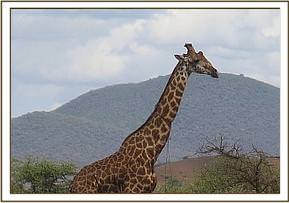

The plain double snare was immediately loosened to avoid negative impact on anesthesia. There was no resultant traumatic wound and the snare was dislodged. A thorough examination was performed and nothing of importance was noted.
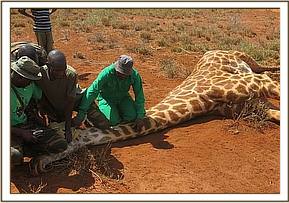

To ease the slight edema observed at the snare location together with anticipated exhaustion, the giraffe was given 100mgs Dexamethasone intramuscularly.
Reversal and Prognosis
The anesthetic was reversed immediately following successful roping with 40mgs Naltrexone mixed with 12mgs Diprenorphine into the jugular vein. Breathing immediately improved and the foreseen breathing difficulties/complications were no longer cause of worry.
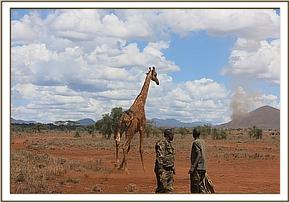

Prognosis is favorable.
Acknowledgement
The Unit takes this opportunity to thank all those who in one way or another made this work a success. Most importantly the Unit sponsor, the David Sheldrick Wildlife Trust, and KWS Fraternity at large. Others include friends of conservation such as Big Life Foundation, the area community Conservancies and well-wishers. It is our hope that the same cooperation will endure as we endeavour to conserve the wildlife species.





















